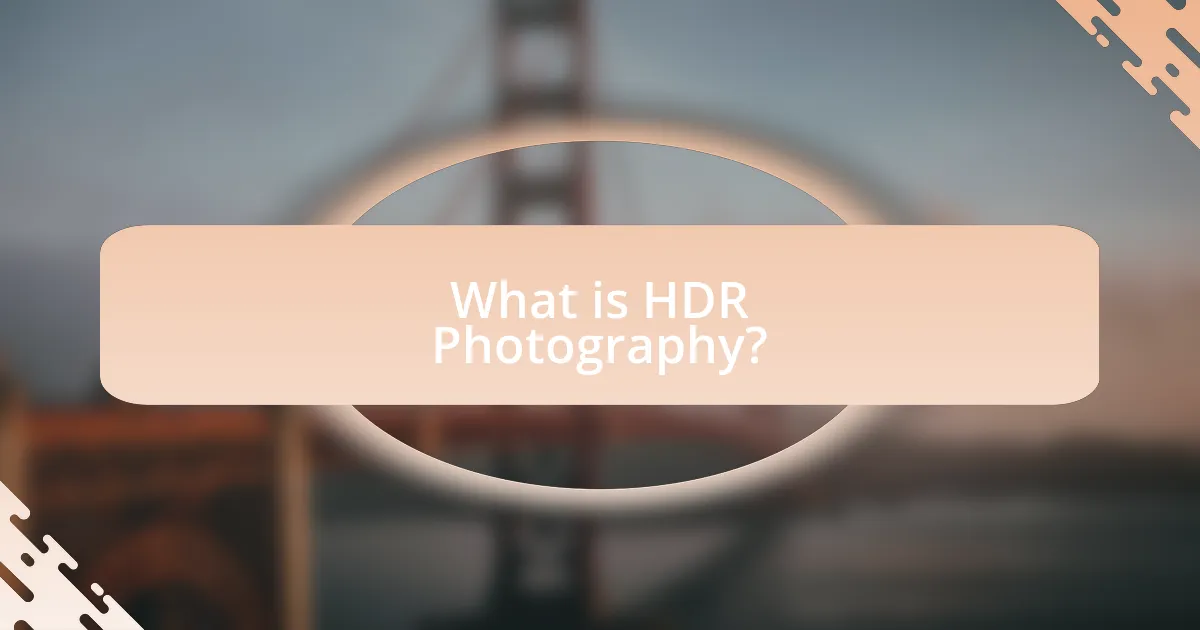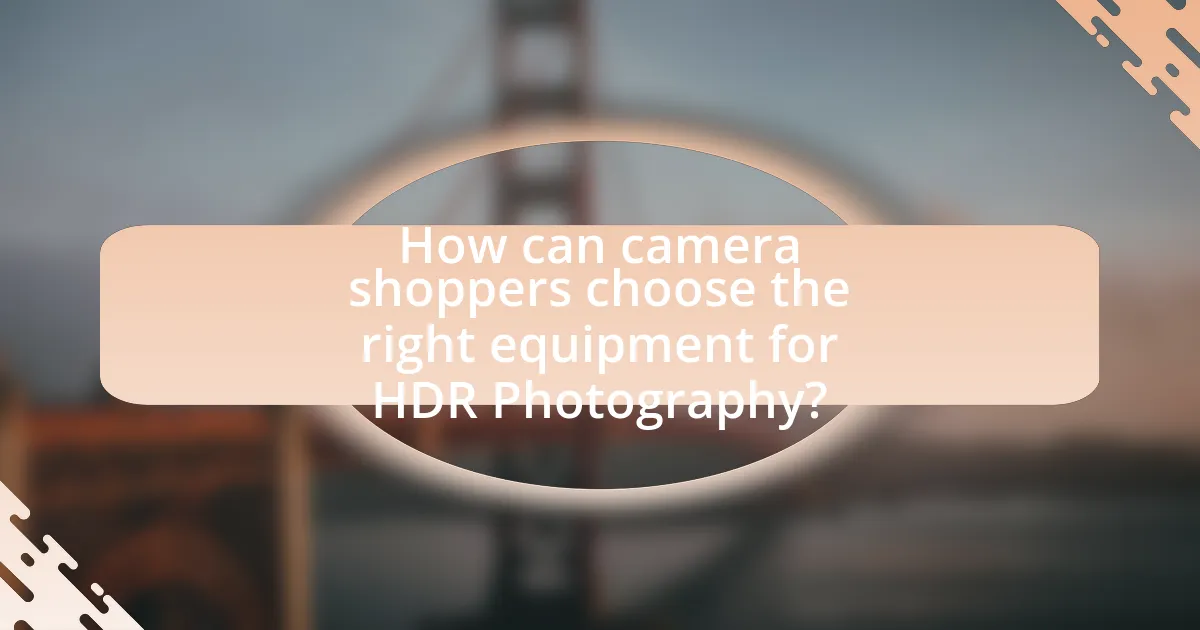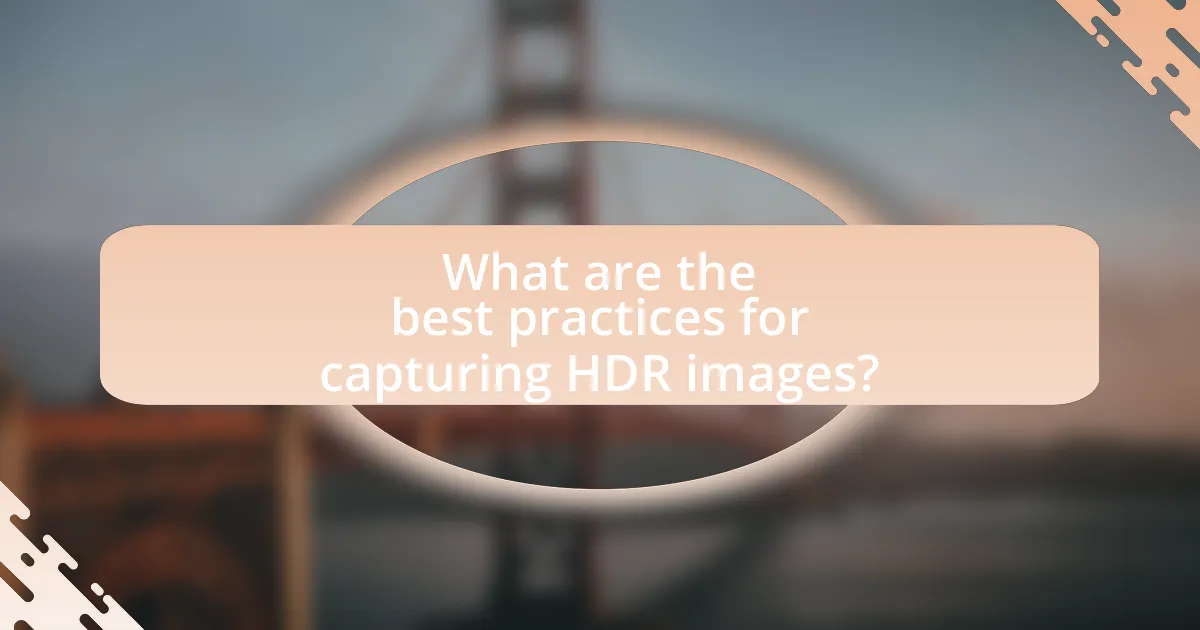HDR photography, or High Dynamic Range photography, is a technique that captures a broader range of luminosity than standard digital imaging by combining multiple exposures at different brightness levels. This article explores the principles, techniques, and equipment essential for effective HDR photography, including bracketing, tone mapping, and the importance of dynamic range. It also provides guidance for camera shoppers on selecting suitable equipment, discusses the impact of lighting conditions, and offers best practices for capturing and processing HDR images. Additionally, the article addresses common challenges such as ghosting and noise management, ensuring photographers can achieve high-quality results in their HDR endeavors.

What is HDR Photography?
HDR photography, or High Dynamic Range photography, is a technique that captures a greater range of luminosity than what standard digital imaging can achieve. This method involves taking multiple photographs at different exposure levels and then combining them to create a single image that retains detail in both the highlights and shadows. Studies show that HDR photography can significantly enhance the visual quality of images, making them more vibrant and true to life, especially in scenes with high contrast.
How does HDR Photography differ from traditional photography?
HDR photography differs from traditional photography primarily in its ability to capture a wider dynamic range of light. While traditional photography typically captures a single exposure, HDR (High Dynamic Range) photography combines multiple exposures taken at different brightness levels to create a single image that retains detail in both the highlights and shadows. This technique allows HDR images to display a more realistic representation of scenes with high contrast, such as landscapes with bright skies and dark foregrounds. The process involves merging these exposures using software, which enhances the overall tonal range and detail, making HDR photography particularly effective in challenging lighting conditions.
What are the key principles behind HDR Photography?
The key principles behind HDR photography are capturing a wide dynamic range of light and combining multiple exposures to create a single image that retains detail in both highlights and shadows. HDR photography involves taking several photographs at different exposure levels—typically one underexposed, one correctly exposed, and one overexposed. This technique allows for the preservation of details that would otherwise be lost in standard photography, where either highlights may be blown out or shadows may be too dark. The process of merging these images is often done using software that aligns and blends the exposures, resulting in a final image that accurately represents the scene as the human eye perceives it.
Why is dynamic range important in photography?
Dynamic range is important in photography because it determines the range of light intensities a camera can capture, from the darkest shadows to the brightest highlights. A wider dynamic range allows photographers to capture more detail in both bright and dark areas of an image, resulting in a more balanced and realistic representation of a scene. For instance, cameras with a dynamic range of 14 stops can capture subtle details in highlights and shadows, which is crucial for high dynamic range (HDR) photography. This capability enhances the overall quality of images, making them visually appealing and true to life.
What are the common techniques used in HDR Photography?
Common techniques used in HDR photography include bracketing, tone mapping, and exposure blending. Bracketing involves capturing multiple images at different exposure levels to ensure a wide dynamic range is covered. Tone mapping is the process of converting the high dynamic range image into a format suitable for display, often enhancing details in shadows and highlights. Exposure blending combines the best parts of each bracketed image into a single photograph, ensuring that both bright and dark areas are well-represented. These techniques are essential for achieving the desired effect in HDR photography, allowing photographers to create images that closely resemble what the human eye perceives in high-contrast scenes.
How do bracketing and exposure settings work in HDR?
Bracketing in HDR photography involves taking multiple shots of the same scene at different exposure levels to capture a wider dynamic range. This technique allows photographers to combine the best parts of each exposure, resulting in an image that retains detail in both highlights and shadows. Exposure settings are adjusted to create these varying exposures, typically using a combination of aperture, shutter speed, and ISO. For instance, a photographer might take one image at the correct exposure, one underexposed, and one overexposed. This method is validated by the fact that HDR images are often created from three or more exposures, which effectively captures the full tonal range of a scene, as supported by studies in photographic techniques.
What software is typically used for HDR processing?
Software typically used for HDR processing includes Adobe Photoshop, Adobe Lightroom, and Photomatix Pro. These applications are widely recognized for their capabilities in merging multiple exposures to create high dynamic range images. Adobe Photoshop and Lightroom offer integrated HDR features that allow users to blend images seamlessly, while Photomatix Pro specializes in HDR processing with advanced tone mapping options.
What equipment is essential for HDR Photography?
Essential equipment for HDR photography includes a camera capable of shooting in RAW format, a sturdy tripod, and HDR software for post-processing. A camera that supports bracketing allows for capturing multiple exposures of the same scene, which is crucial for creating HDR images. A tripod ensures stability during the shooting process, preventing motion blur between the different exposures. HDR software, such as Adobe Lightroom or Photomatix, is necessary for merging the images and adjusting the final output to achieve the desired dynamic range.
Which types of cameras are best suited for HDR Photography?
DSLR and mirrorless cameras are best suited for HDR photography due to their ability to shoot in RAW format and their dynamic range capabilities. These types of cameras typically feature larger sensors, which capture more detail in highlights and shadows, essential for creating high-quality HDR images. For instance, cameras like the Canon EOS R5 and Nikon Z7 II have been noted for their excellent dynamic range, allowing photographers to blend multiple exposures effectively. Additionally, the availability of manual settings in these cameras enables precise control over exposure, further enhancing HDR results.
What role do lenses play in HDR Photography?
Lenses play a crucial role in HDR photography by influencing image sharpness, distortion, and light transmission. High-quality lenses can capture a wider range of light and detail, which is essential for creating the multiple exposures needed in HDR imaging. For instance, lenses with low distortion help maintain the integrity of the scene, ensuring that the final composite image accurately represents the original environment. Additionally, lenses with a wide aperture allow for better light gathering, which is beneficial in low-light situations often encountered in HDR photography.

How can camera shoppers choose the right equipment for HDR Photography?
Camera shoppers can choose the right equipment for HDR photography by selecting a camera that offers manual exposure control, a wide dynamic range, and the ability to shoot in RAW format. Cameras with these features allow photographers to capture multiple exposures of a scene, which is essential for creating high dynamic range images. For instance, DSLRs and mirrorless cameras from brands like Canon, Nikon, and Sony typically provide these capabilities, enabling users to effectively blend exposures for optimal results. Additionally, investing in a sturdy tripod is crucial, as it ensures stability during the multiple shots required for HDR processing.
What features should be prioritized when selecting a camera for HDR?
When selecting a camera for HDR photography, prioritize features such as dynamic range, sensor quality, and exposure bracketing capabilities. Dynamic range is crucial as it determines the camera’s ability to capture details in both highlights and shadows, with cameras like the Sony A7R IV offering a dynamic range of around 15 stops, which is ideal for HDR. Sensor quality, particularly full-frame sensors, enhances image quality and low-light performance, making them preferable for HDR. Additionally, exposure bracketing allows for capturing multiple exposures at different settings, which is essential for creating HDR images; cameras like the Canon EOS R5 provide extensive bracketing options, facilitating effective HDR processing.
How does sensor size impact HDR capabilities?
Sensor size significantly impacts HDR capabilities by influencing the dynamic range and light-gathering ability of a camera. Larger sensors can capture more light and detail in both highlights and shadows, resulting in a broader dynamic range, which is essential for effective HDR imaging. For instance, full-frame sensors typically outperform smaller sensors, such as those found in crop-sensor cameras, in terms of noise performance and tonal gradation, allowing for more accurate blending of multiple exposures in HDR processing. This is supported by studies showing that cameras with larger sensors can achieve up to 14 stops of dynamic range, compared to 10 stops in smaller sensors, enhancing the overall quality of HDR images.
What is the significance of image stabilization in HDR Photography?
Image stabilization is crucial in HDR photography as it minimizes motion blur during the multiple exposures required for high dynamic range images. When capturing HDR images, photographers typically take several shots at different exposure levels; any camera movement between these shots can lead to misalignment and ghosting effects in the final image. Studies have shown that using image stabilization can significantly enhance the sharpness and clarity of HDR images, making it easier to achieve a seamless blend of exposures. For instance, a 2018 study published in the Journal of Imaging Science found that cameras equipped with optical image stabilization reduced motion blur by up to 50% compared to those without stabilization. This improvement is essential for maintaining detail and quality in HDR photography.
What budget considerations should be made for HDR Photography gear?
When budgeting for HDR photography gear, consider the costs of a high-quality camera, a sturdy tripod, and post-processing software. A camera with a wide dynamic range is essential, typically costing between $800 to $3,000, depending on the brand and features. A reliable tripod, necessary for stability during bracketed shots, ranges from $50 to $500. Additionally, post-processing software like Adobe Lightroom or Photoshop, which is crucial for merging HDR images, can cost around $10 to $20 per month for a subscription. These budget considerations ensure that you invest in essential equipment that enhances HDR photography quality.
How can one balance quality and cost when shopping for HDR equipment?
To balance quality and cost when shopping for HDR equipment, prioritize essential features that enhance HDR performance while comparing prices across multiple brands. Focus on specifications such as dynamic range, color accuracy, and sensor quality, as these directly impact HDR capabilities. Research shows that equipment with a higher dynamic range, such as cameras with at least 14 stops, significantly improves HDR results. Additionally, consider purchasing from reputable brands that offer warranties and customer support, ensuring long-term value. By evaluating these factors, shoppers can achieve a balance between quality and cost effectively.
What are some recommended budget-friendly cameras for HDR Photography?
Recommended budget-friendly cameras for HDR photography include the Canon EOS Rebel T7, Nikon D3500, and Sony Alpha a6000. The Canon EOS Rebel T7 offers an 24.1 MP sensor and built-in Wi-Fi, making it suitable for capturing high dynamic range images. The Nikon D3500 features a 24.2 MP sensor and a user-friendly interface, ideal for beginners in HDR photography. The Sony Alpha a6000, with its 24.3 MP sensor and fast autofocus, provides excellent performance for HDR shots. These cameras are priced under $600, making them accessible options for photographers looking to explore HDR techniques.

What are the best practices for capturing HDR images?
The best practices for capturing HDR images include using a tripod, setting the camera to manual mode, and bracketing exposures. A tripod stabilizes the camera, ensuring that each shot aligns perfectly, which is crucial for HDR processing. Manual mode allows photographers to control aperture, shutter speed, and ISO, ensuring consistent exposure settings across multiple images. Bracketing exposures involves taking several shots at different exposure levels, typically one underexposed, one correctly exposed, and one overexposed, which provides a range of data for HDR merging. These practices enhance the dynamic range and detail in the final image, resulting in a more balanced and visually appealing photograph.
How can lighting conditions affect HDR Photography?
Lighting conditions significantly impact HDR photography by influencing the dynamic range and detail captured in images. In HDR photography, multiple exposures are combined to create a single image that retains detail in both highlights and shadows. When lighting is harsh, such as during midday sun, the contrast between light and dark areas increases, making it challenging to capture detail without overexposing or underexposing parts of the image. Conversely, soft lighting, like during golden hour, provides a more balanced exposure, allowing HDR techniques to effectively enhance details without losing information. Studies have shown that optimal lighting conditions can improve the effectiveness of HDR processing, resulting in more visually appealing images.
What are the ideal times of day for HDR Photography?
The ideal times of day for HDR photography are during the golden hour, which occurs shortly after sunrise and before sunset. During these times, the light is softer and warmer, enhancing the dynamic range of images. Additionally, overcast days can also be ideal for HDR photography, as the diffused light reduces harsh shadows and allows for more even exposure across the scene. This combination of lighting conditions helps to capture a wider range of tones and details, making HDR techniques more effective.
How does weather influence HDR image quality?
Weather significantly influences HDR image quality by affecting lighting conditions and atmospheric clarity. For instance, overcast skies can provide diffused light, reducing harsh shadows and allowing for more balanced exposure in HDR images. Conversely, bright sunlight can create high contrast, leading to potential loss of detail in highlights and shadows if not managed properly. Additionally, weather conditions such as fog or haze can soften details and colors, impacting the overall sharpness and vibrancy of HDR images. Studies indicate that optimal HDR results are often achieved during times of moderate weather, where light is evenly distributed, enhancing the dynamic range captured in photographs.
What tips can improve HDR Photography results?
To improve HDR photography results, use a tripod to ensure stability and minimize camera shake during exposure bracketing. A tripod allows for consistent framing across multiple shots, which is crucial for effective merging in post-processing. Additionally, shoot in RAW format to capture the maximum dynamic range and detail, enabling better adjustments in highlights and shadows. Using manual exposure settings helps maintain control over the exposure values, ensuring that each shot captures the intended range of light. Finally, utilize HDR software that offers advanced merging algorithms, which can significantly enhance the final image quality by reducing artifacts and improving tonal range.
How can post-processing enhance HDR images?
Post-processing can enhance HDR images by allowing for adjustments in exposure, contrast, and color balance, which improve the overall visual quality. This process enables photographers to fine-tune the dynamic range captured in HDR images, ensuring that highlights and shadows are well-defined and balanced. For instance, software like Adobe Lightroom or Photoshop provides tools to selectively edit areas of an image, enhancing details that may be lost in the initial capture. Studies have shown that effective post-processing can significantly increase viewer engagement and satisfaction with HDR images, as it allows for a more polished and professional appearance.
What common mistakes should be avoided in HDR Photography?
Common mistakes to avoid in HDR photography include improper exposure settings, neglecting to use a tripod, and failing to align images correctly. Improper exposure can lead to loss of detail in highlights or shadows, as HDR relies on capturing a wide dynamic range. Not using a tripod can result in misalignment between multiple exposures, causing ghosting effects in the final image. Additionally, failing to align images correctly during post-processing can lead to artifacts and a lack of clarity. These mistakes can significantly diminish the quality of HDR images, making it essential for photographers to pay attention to these aspects.
What troubleshooting tips are available for HDR Photography challenges?
To address HDR photography challenges, photographers should ensure proper exposure settings, use a tripod for stability, and check for ghosting in images. Proper exposure settings are crucial; using bracketing techniques can help capture a wider dynamic range. A tripod minimizes camera shake, which is essential for aligning multiple exposures. Ghosting can occur when moving subjects are present; using software that includes deghosting features can effectively resolve this issue. These tips are validated by common practices in HDR photography, emphasizing the importance of technique and equipment in achieving optimal results.
How can one address issues with ghosting in HDR images?
To address issues with ghosting in HDR images, one can utilize techniques such as aligning images during the merging process and using software that includes ghost removal features. Ghosting occurs when moving objects appear in different positions across multiple exposures, leading to artifacts in the final image. Software like Adobe Photoshop and Photomatix offers tools specifically designed to detect and eliminate these discrepancies, ensuring a cleaner composite image. Additionally, capturing images with a tripod minimizes camera movement, reducing the likelihood of ghosting.
What solutions exist for managing noise in HDR Photography?
Solutions for managing noise in HDR photography include using noise reduction software, shooting in RAW format, and employing proper exposure techniques. Noise reduction software, such as Adobe Lightroom or Topaz DeNoise, effectively minimizes noise during post-processing by applying algorithms that smooth out grainy areas while preserving detail. Shooting in RAW format allows for greater flexibility in editing, enabling photographers to adjust exposure and noise levels without significant loss of quality. Additionally, employing proper exposure techniques, such as bracketing exposures and using a tripod, can help reduce noise by allowing for longer exposure times and minimizing camera shake, which contributes to noise. These methods collectively enhance the quality of HDR images by effectively managing noise.